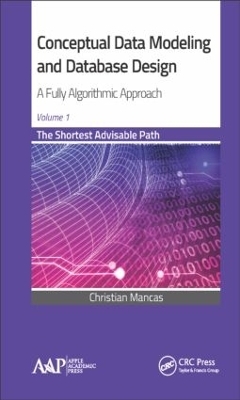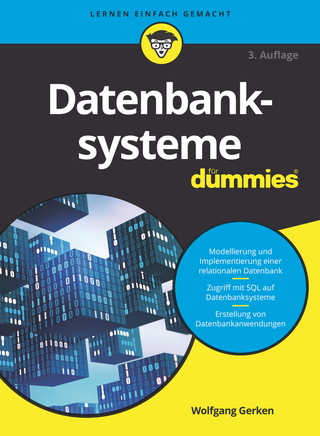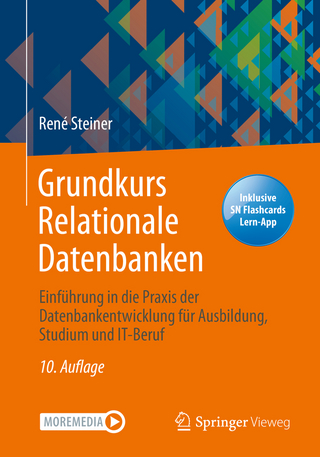
Conceptual Data Modeling and Database Design: A Fully Algorithmic Approach, Volume 1
Apple Academic Press Inc. (Verlag)
978-1-77188-124-1 (ISBN)
This new book aims to provide to both beginners and experts with a completely algorithmic approach to data analysis and conceptual modeling, database design, implementation, and tuning, starting from vague and incomplete customer requests and ending with IBM DB/2, Oracle, MySQL, MS SQL Server, or Access based software applications. A rich panoply of solutions to actual useful data sub-universes (e.g. business, university, public and home library, geography, history, etc.) is provided, constituting a powerful library of examples.
Four data models are presented and used: the graphical Entity-Relationship, the mathematical EMDM, the physical Relational, and the logical deterministic deductive Datalogones. For each one of them, best practice rules, algorithms, and the theory beneath are clearly separated. Four case studies, from a simple public library example, to a complex geographical study are fully presented, on all needed levels.
Several dozens of real life exercises are proposed, out of which at least one per chapter is completely solved. Both major historical and up-to-date references are provided for each of the four data models considered.
The book provides a library of useful solutions to real-life problems and provides valuable knowledge on data analysis and modeling, database design, implementation, and fine tuning.
The BookAuthority.org (https://bookauthority.org/author/Christian-Mancas) has recognised Conceptual Data Modeling and Database Design in 16 categories: Data Modeling, Database Design, Database Theory, Relational Databases, Database Schema, Databases, Data Processing, and Algorithms, for both Beginners and All Time. Readers mostly appreciate its pragmatic, gentle, pedagogical, and algorithmic approach, its valuable knowledge and best practice rules, as well as its real-life examples and fully presented case studies.
Christian Mancas, PhD, is currently an associate professor with both the Mathematics and Computer Science Departments of Ovidius University, Constanta, Romania, and the Engineering Taught in Foreign Languages Department (Computer Science and Telecommunications in English stream) of Politehnica University, Bucharest, Romania (as an invited professor). Since 2012, he is also a database architect with Asentinel International srl, Bucharest, a subsidiary of Asentinel LLC, Memphis, Tennessee. His specialties include university teaching, R&D, business analysis, conceptual data and knowledge modeling and querying, client-server, hierarchical software architecture, object-oriented, event-driven design, structured development, complex project and small IT company management, Datalog, SQL, C#, XML programming, etc. Professor Christian Mancas has published dozens of scientific papers (in Romania, USA, Austria, and Greece), which have been indexed by ACM Digital Library, Zentralblatt, Scopus, DBLP, Arnetminer, Researchr, TDGS, SCEAS, etc. He has also published three books in Romanian and dozens of reviews (mostly in USA, including ACM Reviews). He was a Program Committee member and session chairman for several software conferences in USA, Austria, and Romania, and he is a member of several associations (including ACM, the Romanian Mathematics Sciences Society, and the International Who’s Who of Professionals). Since 2006, his biography is included in Marquis Who’s Who in the World and Who’s Who in Science and Engineering and Hubners’ Who’s Who in Romania. Since 1990, he also worked for several IT startups, including his own DATASIS Consult srl (co-owned with his good friend and faculty colleague Ion Draghicescu) and DATASIS ProSoft srl (who had 25 programmers working for the design and development of several ERP-type database applications for customers from France, UK, Switzerland, USA, Israel, Greece, and Romania). His main research areas are conceptual data and knowledge modeling and querying; database design, implementation, and optimization; as well as the architecture, design, development, fine-tuning, and maintenance of data and knowledge base management systems. Dr. Mancas graduated in 1977 from the Computers Department of Politehnica University of Bucharest, Romania, with a thesis on Generating Parsers for LR(k) Grammars, under the supervision of Professor Dan Luca Serbanati. Up until the fall of communism in 1990, he worked as a software engineer and, since 1980, R&D manager of a state-owned Computer Center in Bucharest (contributing to the design, development, and maintenance of a dedicated ERP), also conducting (from time to time) computer programming labs at Politehnica University of Bucharest, but for political reasons, he was not accepted for PhD studies. He started this program under the supervision of Professor Cristian Giumale in 1992 and obtained his PhD in 1997 from the above department, with a thesis on Conceptual Data and Knowledge Modeling.
Chapter 2. The Quest for Data Adequacy and Simplicity: The Entity-Relationship Data Model (E-RDM)
2.1 Entity and relationship type object sets
2.2 Attributes and surrogate keys
2.3 Entity-Relationship Diagrams (E-RDs)
2.4 Functional relationships and the Key Propagation Principle (KPP)
2.5 Relationship hierarchies
2.6 Higher arity non-functional relationships
2.7 Restriction sets
2.8 Case study: a public library (do we know exactly what a book is?)
2.9 The algorithm for assisting the data analysis and modeling process (A0). An E-R data model of the E-RDM
2.10 Best practice rules
2.11 The math behind E-RDs and restriction sets. The danger of “many-to-many relationships” and the correct E-RD of E-RDM
Chapter 3. The Quest for Data Independence, Minimal Plausibility, and Formalization: The Relational Data Model (RDM)
3.1 First normal form tables, columns, constraints, rows, instances
3.2 The five basic relational constraint types
3.3 The algorithm for translating E-R data models into relational schemas and non-relational constraint sets (A1-7). An RDM model of the E-RDM
3.4 Case study: the relational scheme of the public library data model
3.5 The reverse engineering algorithm for translating relational schemas into E-R data models (REA1-2)
3.6 The algorithm for assisting keys discovery (A7/8-3)
3.7 RDBMS metacatalogs. Relational and E-R data models of the RDM
3.8 Relational schemas definition. SQL DDL
3.9 Relational instances manipulation. SQL DML. Relational calculi and algebra
3.10 Higher and the highest RDM normal forms
3.11 Best practice rules
3.12 The math behind RDM
Chapter 4: Relational Schemas Implementation and Reverse Engineering
4.1 The algorithm for translating relational schemas into SQL DDL ANSI-92 scripts (A8)
4.2 Relevant differences between IBM DB2, Oracle Database and MySQL, Microsoft SQL Server and Access
4.3 Case study: implementing the public library RDB into DB2, Oracle, MySQL, SQL Server, and Access
4.4 The reverse engineering algorithm for translating Access 2013 RDB schemas into SQL ANSI DDL scripts (REA2013A0), a member of REAF0’
4.5 The algorithms for translating E-R data models into RDBs and associated non-relational constraint sets (AF1-8)
4.6 The reverse engineering family of algorithms for translating RDB schemas into E-R data models (REAF0-2)
4.7 Case study: reverse engineering of an Access Stocks DB scheme into both an ANSI standard SQL DDL script and an E-R data model
4.8 Best practice rules
4.9 The math behind the algorithms presented in this chapter
Chapter 5: Conclusion
5.1 Database axioms
5.2 Why do we need another conceptual level for expert DB design?
5.3 What are the most important things that we should be aware of in DBs?
Appendix: Mathematic prerequisites for the math behind
Index
| Zusatzinfo | 184 Illustrations, black and white |
|---|---|
| Verlagsort | Oakville |
| Sprache | englisch |
| Maße | 152 x 229 mm |
| Gewicht | 1450 g |
| Themenwelt | Mathematik / Informatik ► Informatik ► Datenbanken |
| Mathematik / Informatik ► Mathematik ► Analysis | |
| Mathematik / Informatik ► Mathematik ► Angewandte Mathematik | |
| ISBN-10 | 1-77188-124-0 / 1771881240 |
| ISBN-13 | 978-1-77188-124-1 / 9781771881241 |
| Zustand | Neuware |
| Haben Sie eine Frage zum Produkt? |
aus dem Bereich


